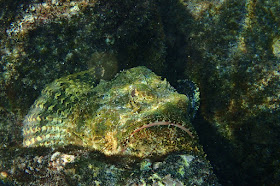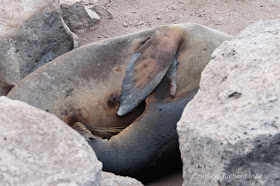As we sailed towards our afternoon destination, the island of Santa Fé, an announcement came that dolphins had been spotted. Our friend Rick had been skeptical that our ship would ever change course for wildlife, and possibly upset a schedule, despite our assurances that Lindblad did indeed do that, and often. The ironclad Lindblad rule is to never get so close, or come up so fast, that the animals' natural behavior is disturbed.
I didn't catch any worthwhile photos, but Rick did. Thank him for these views of dolphins, sea lions, and sea birds all attacking a school of fish.
Here we're following the dolphins at a respectful distance.
Rick took these pictures before the hunting grew too frenzied with the arrival of sea lions.
Here we have a dolphin, two sea lions, and a frigate bird hovering over the action.
Towards the end the birds dominated the scene, with diving boobies, pelicans, and kleptoparasitic frigates.
At Santa Fé our first activity was snorkeling in a protected cove. I still wore the flotation vest, but this time I took the waterproof camera along. I wore a standard facemask, although I'm somewhat nearsighted and presbyopic, because I wasn't going to invest in a corrective mask before I'd ever snorkeled. This led to sometimes putting the camera controls in the wrong position, but there were still interesting shots taken.
Here's a picture with a partially inflated flotation vest. The amount of air the snorkeler blows into the vest determines the degree of buoyancy.
The vest makes it effortless to float, and to stick your head up and look around. However, it will prevent diving.
I discovered at the pool where I took an introductory snorkeling lesson that going down more than about 10 feet started to hurt my ears, so diving wasn't a big temptation except in shallow waters.
The snorkelers needed to stay together to allow the monitoring zodiacs to keep an eye on everyone. Part of my attention was dedicated to not bumping or kicking someone, or being bumped.
I also needed to stick close to my snorkeling buddy, Joan. But one of my closest encounters, early in the swim, was with a pair of sea lions. My camera was on the wrong setting, but this out-of-focus image will give you the idea.
This sea lion had a hook in his mouth with a foot or two of trailing line. Joan alerted the naturalist in the zodiac, but the only action available to Lindblad was to alert the park rangers.
There were colorful little fishies,
and the best picture of the day, when Joan spotted this stone scorpionfish, which lurks in camouflage for something edible to pass by. Do not touch -- the spines are poisonous.
There were fleets of king angelfish.
And sergeant majors.
These are probably rainbow wrasse.
These unlikely creatures are cornet fish.
Here a yellowtail surgeonfish is passing in front of a white-tipped reef shark. This shark species is not interested in humans, and is a common sight while snorkeling in shallow water.
By the end one of my toes was being rubbed by the fin, and my calves were complaining. I was relieved for the swim to be over, unlike the first two snorkels which were over too soon.
After snorkeling we took a short hike on Santa Fé as the sun drooped lower. This island had been overrun by goats and donkeys installed by humans, but these have been successfully eradicated.
There were land iguanas from the get-go.
Many of the travelers stopped for a pose at this majestic cactus-tree, including Joan and me.
Nearby one cactus pad hosted a peephole.
Another posing iguana.
The iguana's favorite food, the cactus blossom.
An iguana with a beer belly. Cactus belly? A cargo of eggs?
In any case, it approached us.
A closeup. The right is my good side.
Rick took this photo of the iguana approaching Joan's boot. It nonchalantly kept going, and then waddled off into the rocks.
Yes, the wildlife was unconcerned. This sea lion was napping across the trail.
It had the right-of-way, so we detoured around it.
Rick spotted a sea lion mother and pup nursing, hidden by rocks.
Our walk ended back at the beach, facing the cove in which we'd snorkeled.
A ray moved through the shallow edge of the waters.
A sea lion pup was trying to decide where to go next.
And then we saw why these creatures weren't out in the cove. The naturalists explained that this was the fin of a galapagos shark, a species that often reaches 3 meters (~10 ft.) in length.
It can be aggressive, and had it appeared while we were snorkeling, we would have been recalled immediately!
Then it was time to return to the Islander after another successful day.

































How wonderful! Thank you for sharing this!
ReplyDelete